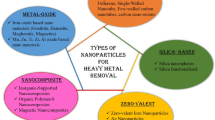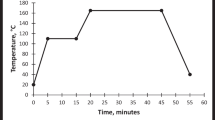Abstract
The authors describe the preparation of a nanocomposite (mag-MoS2-Fe3O4) that was prepared from molybdenum disulfide (MoS2) and magnetic Fe3O4 nanoparticles by a hydrothermal method in an inert atmosphere. The composite is shown to be a viable magnetic adsorbent for dispersive solid phase microextraction of lead(II) and copper(II) ions from water and plant samples. The nanocomposite was characterized by FT-IR, Raman spectroscopy, XRD, SEM, and BET methods. The factors affecting the extraction recovery of the analytes, including the pH value, type of dispersive solvent, sample volume, type and volume of eluent solution, and interfering ions, were optimized. Flame atomic absorption spectrometry was then used for quantitation. Figures of merit of this method include a preconcentration factor of 50 for lead(II) and 35 for Cu(II), LODs of 3.3 μg·L−1 for lead(II) and of 1.8 μg·L−1 for Cu(II), and RSDs of 4.9 and 1.5%, respectively. The method was used to preconcentrate the analytes from plant and water samples prior to their determination by FAAS. It was then validated by analyzing certified reference materials (water and plant), and this resulted in good accuracy.

Schematic presentation of a nanocomposite (mag-MoS2-Fe3O4) that was prepared from molybdenum disulfide (MoS2) and magnetic Fe3O4 nanoparticles by a hydrothermal method in an inert atmosphere for the solid phase microextraction of lead and copper at trace levels.
Similar content being viewed by others

References
Goyer RA, Clarkson TW (1996) Toxic effects of metals. Casarett & Doull’s Toxicology The Basic Science of Poisons, Fifth Edition, Klaassen, CD [Ed] McGraw-Hill Health Professions Division, ISBN 71054766
Ghaedi M, Niknam K, Kokhdan SN, Soylak M (2013) Combination of flotation and flame atomic absorption spectrometry for determination, Preconcentration and separation of trace amounts of metal ions in biological samples. Hum Exp Toxicol 32:504–512
Patrick L (2006) Lead toxicity part II: the role of free radical damage and the use of antioxidants in the pathology and treatment of lead toxicity. Altern Med Rev 11:114–122
Goudarzi N (2007) Determination of trace amounts of copper in river and sea water samples by flame atomic absorption spectrometry (FAAS) after cloud-point preconcentration. J Braz Chem Soc 18:1348–1352
Matoso E, Kubota L, Cadore S (2003) Use of silica gel chemically modified with zirconium phosphate for preconcentration and determination of lead and copper by flame atomic absorption spectrometry. Talanta 60:1105–1111
Soylak M, Elci L (2000) Solid phase extraction of trace metal ions in drinking water samples from Kayseri-Turkey. J Trace Microprobe Tech 18:397–403
Shemirani F, Abkenar SD, Khatouni A (2004) Determination of trace amounts of lead and copper in water samples by flame atomic absorption spectrometry after cloud point extraction. B Kor Chem Soc 25:1133–1136
Sharma S, Rahman N, Azmi SNH, Iqbal B, Amburk MIBB, Al Barwani ZMH (2010) UV spectrophotometric determination of cu (II) in synthetic mixture and water samples. J Chin Chem Soc 57:622–631
Abson D, Lipscomb AG (1957) The determination of lead and copper in organic materials (foodstuffs) by a dry-ashing procedure. Analyst 82:152–160
Wadhwa SK, Tuzen M, Kazi TG, Soylak M, Hazer B (2014) Polyhydroxybutyrate-b-polyethyleneglycol block copolymer for the solid phase extraction of lead and copper in water, baby foods, tea and coffee samples. Food Chem 152:75–80
Soylak M, Elci L (1997) Preconcentration and separation of trace metal ions from sea water samples by use of Amberlite XAD-16 after complexation with sodium Diethyldithiocarbamate. Int J Environ Anal Chem 66:51–59
Jalbani N, Soylak M (2015) Ligandless ultrasonic-assisted and ionic liquid-based dispersive liquid–liquid microextraction of copper, nickel and lead in different food samples. Food Chem 167:433–437
Saracoglu S, Soylak M, Elci L (2001) Enrichment and separation of traces of cadmium, chromium, lead and manganese ions in urine by using magnesium hydroxide Coprecipitation method. Trace Elem Electrolytes 18:129–133
Mehdinia A, Shoormeij Z, Jabbari A (2017) Trace determination of lead(II) ions by using a magnetic nanocomposite of the type Fe3O4/TiO2/PPy as a sorbent, and FAAS for quantitation. Microchim Acta 184(5):1529–1537
Zendelovska D, Pavlovska G, Cundeva K, Stafilov T (2001) Electrothermal atomic absorption spectrometric determination of cobalt, copper, lead and nickel traces in aragonite following flotation and extraction separation. Talanta 54:139–146
Abulhassani J, Manzoori JL, Amjadi M (2010) Hollow fiber based-liquid phase microextraction using ionic liquid solvent for preconcentration of lead and nickel from environmental and biological samples prior to determination by electrothermal atomic absorption spectrometry. J Hazard Mater 176:481–486
Aydin FA, Soylak M (2010) Separation, preconcentration and inductively coupled plasma-mass spectrometric (ICP-MS) determination of thorium (IV), titanium (IV), iron (III), lead (II) and chromium (III) on 2-nitroso-1-naphthol impregnated MCI GEL CHP20P resin. J Hazard Mater 173:669–674
Djedjibegovic J, Larssen T, Skrbo A, Marjanović A, Sober M (2012) Contents of cadmium, copper, mercury and lead in fish from the Neretva river (Bosnia and Herzegovina) determined by inductively coupled plasma mass spectrometry (ICP-MS). Food Chem 131:469–476
Zhao L, Zhong S, Fang K, Qian Z, Chen J (2012) Determination of cadmium (II), cobalt (II), nickel (II), lead (II), zinc (II), and copper (II) in water samples using dual-cloud point extraction and inductively coupled plasma emission spectrometry. J Hazard Mater 239:206–212
Khuder A, Bakir M, Hasan R, Mohammad A (2008) Determination of nickel, copper, zinc and lead in human scalp hair in Syrian occupationally exposed workers by total reflection X-ray fluorescence. Environ Monit Assess 143(1):67–74
Pastor-Belda M, Garrido I, Campillo N, Viñas P, Hellín P, Flores P, Fenoll J (2015) Dispersive liquid–liquid microextraction for the determination of new generation pesticides in soils by liquid chromatography and tandem mass spectrometry. J Chromatogr A 1394:1–8
Zgoła-Grześkowiak A, Grześkowiak T (2011) Dispersive liquid-liquid microextraction. TrAC, Trends Anal Chem 30:1382–1399
Shang Y, Luo J, Wang P, Zhao X, Ye C, Guo S (2016) Magnetic solid-phase extraction based on β-Cyclodextrins/acrylic acid modified magnetic gelatin for determination of Moxidectin in milk samples. J Anal Methods Chem 2016:6
Chen J, Zhu X (2016) Magnetic solid phase extraction using ionic liquid-coated core-shell magnetic nanoparticles followed by high-performance liquid chromatography for determination of rhodamine B in food samples. Food Chem 200:10–15
Kazemi E, Dadfarnia S, Haji Shabani AM (2015) Dispersive solid phase microextraction with magnetic graphene oxide as the sorbent for separation and preconcentration of ultra-trace amounts of gold ions. Talanta 141:273–278
Islas G, Rodríguez JA, Páez-Hernández ME, Corona-Avendaño S, Rojas-Hernández A, Barrado E (2016) Dispersive solid-phase extraction based on butylamide silica for the determination of sulfamethoxazole in milk samples by capillary electrophoresis. J Liq Chromatogr Relat Technol 39:658–665
Ghorbani M, Chamsaz M, Rounaghi GH, Aghamohammadhasani M, Seyedin O, Lahoori NA (2016) Development of a novel ultrasonic-assisted magnetic dispersive solid-phase microextraction method coupled with high performance liquid chromatography for determination of mirtazapine and its metabolites in human urine and water samples employing experimental design. Anal Bioanal Chem 408:7719–7729
Xu M, Liang T, Shi M, Chen H (2013) Graphene-like two-dimensional materials. Chem Rev 113:3766–3798
Qu B, Sun Y, Liu L, Li C, Yu C, Zhang X, Chen Y (2017) Ultrasmall Fe2O3 nanoparticles/MoS2 nanosheets composite as high-performance anode material for lithium ion batteries. Sci Rep 7:42772
Zhu X, Yang C, Xiao F, Wang J, Su X (2015) Synthesis of nano-TiO2-decorated MoS2 nanosheets for lithium ion batteries. New J Chem 39:683–688
Ghanemi K, Nikpour Y, Omidvar O, Maryamabadi A (2011) Sulfur-nanoparticle-based method for separation and preconcentration of some heavy metals in marine samples prior to flame atomic absorption spectrometry determination. Talanta 85:763–769
Tuzen M, Saygi KO, Soylak M (2008) Solid phase extraction of heavy metal ions in environmental samples on multiwalled carbon nanotubes. J Hazard Mater 152:632–639
Liang P, Ding Q, Song F (2005) Application of multiwalled carbon nanotubes as solid phase extraction sorbent for preconcentration of trace copper in water samples. J Sep Sci 28:2339–2343
Vellaichamy S, Palanivelu K (2011) Preconcentration and separation of copper, nickel and zinc in aqueous samples by flame atomic absorption spectrometry after column solid-phase extraction onto MWCNTs impregnated with D2EHPA-TOPO mixture. J Hazard Mater 185:1131–1139
Su S, He M, Zhang N, Cui C (2014) Calconcarboxylic acid dynamically modified nanometer-sized zirconia for on-line flow injection-inductively coupled plasma optical emission spectrometry determination of trace heavy metals in environmental water samples. Anal Methods 6:1182–1188
Yang B, Gong Q, Zhao L, Sun H, Ren N, Qin J, Xu J, Yang H (2011) Preconcentration and determination of lead and cadmium in water samples with a MnO2 coated carbon nanotubes by using ETAAS. Desalination 278:65–69
ALOthman ZA, Habila M, Yilmaz E, Soylak M (2012) Solid phase extraction of cd (II), Pb (II), Zn (II) and Ni (II) from food samples using multiwalled carbon nanotubes impregnated with 4-(2-thiazolylazo) resorcinol. Microchim Acta 177:397–403
Karimi M, Shabani AMH, Dadfarnia S (2016) Deep eutectic solvent-mediated extraction for ligand-less preconcentration of lead and cadmium from environmental samples using magnetic nanoparticles. Microchim Acta 183:563–571
Ghorbani-Kalhor E (2016) A metal-organic framework nanocomposite made from functionalized magnetite nanoparticles and HKUST-1 (MOF-199) for preconcentration of cd (II), Pb (II), and Ni (II). Microchim Acta 183:2639–2647
Zawisza B, Baranik A, Malicka E, Talik E, Sitko R (2016) Preconcentration of Fe (III), co (II), Ni (II), cu (II), Zn (II) and Pb (II) with ethylenediamine-modified graphene oxide. Microchim Acta 183:231–240
Habila MA, ALOthman ZA, El-Toni AM, Labis JP, Li X, Zhang F, Soylak M (2016) Mercaptobenzothiazole-functionalized magnetic carbon Nanospheres of type Fe3O4@SiO2@C for the Preconcentration of nickel, copper and lead prior to their determination by ICP-MS. Microchim Acta 183:2377–2384
Behbahani M, Bide Y, Bagheri S, Salarian M, Omidi F, Nabid MR (2016) A pH responsive nanogel composed of magnetite, silica and poly (4-vinylpyridine) for extraction of cd (II), cu (II), Ni (II) and Pb (II). Microchim Acta 183:111–121
Pytlakowska K (2016) Dispersive micro solid-phase extraction of heavy metals as their complexes with 2-(5-bromo-2-pyridylazo)-5-diethylaminophenol using graphene oxide nanoparticles. Microchim Acta 183:91–99
Pourreza N, Rastegarzadeh S, Larki A (2014) Simultaneous preconcentration of cd (II), cu (II) and Pb (II) on Nano-TiO 2 modified with 2-mercaptobenzothiazole prior to flame atomic absorption spectrometric determination. J Ind Eng Chem 20:2680–2686
Soylak M, Acar D, ALOthman ZA (2017) Activated carbon cloth as efficient adsorbent for traces cu(II), co(II), cd(II), Pb(II), Mn(II) and Ni(II) as O-O-diethylphosphorodithioic acid chelates for the enrichment from water and soil samples. At Spectrosc 38:65–70
Manoochehri M, Naghibzadeh L (2017) A nanocomposite based on Dipyridylamine functionalized magnetic Multiwalled carbon nanotubes for separation and Preconcentration of toxic elements in black tea leaves and drinking water. Food Anal Methods 10:1777–1786
Acknowledgements
Neda Baghban is thankful to the Scientific and Technological Research Council of Turkey (TUBITAK) under “2216 Research Fellowship Programme for Foreign Citizens” for financial support.
Author information
Authors and Affiliations
Corresponding author
Ethics declarations
The author(s) declare that they have no competing interests.
Electronic supplementary material
ESM 1
(DOCX 579 kb)
Rights and permissions
About this article
Cite this article
Baghban, N., Yilmaz, E. & Soylak, M. A magnetic MoS2-Fe3O4 nanocomposite as an effective adsorbent for dispersive solid-phase microextraction of lead(II) and copper(II) prior to their determination by FAAS. Microchim Acta 184, 3969–3976 (2017). https://doi.org/10.1007/s00604-017-2384-z
Received:
Accepted:
Published:
Issue Date:
DOI: https://doi.org/10.1007/s00604-017-2384-z



